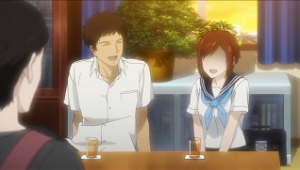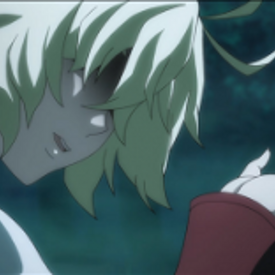 Samurai Flamenco #19: …okay, there was one possibility I hadn’t thought of. Who’d suspect Goto, of all people, of having an imaginary (sort of) girlfriend? Even handling everyday life, this show has lost none of its ability to drop surprises on the viewer from out of left field.
Samurai Flamenco #19: …okay, there was one possibility I hadn’t thought of. Who’d suspect Goto, of all people, of having an imaginary (sort of) girlfriend? Even handling everyday life, this show has lost none of its ability to drop surprises on the viewer from out of left field.
Now that we know that the world responds to Masayoshi’s wishes, what happens next must have been triggered by his desire to do something for Goto. It’s really not clear how that leads to having an underage vigilante blow up his apartment, though. Some kind of international terrorist conspiracy, perhaps, that will lead to Goto’s girlfriend being found miraculously alive?
 Nobunagun #10: After playing coy about the E-Gene powers of the people in charge of Dogoo, the story finally tells us: they don’t have them because they’re the extraordinary historical individuals themselves. That was a terrific interlude, but at the same time it felt a little rushed. I’d love to have seen Iyo’s life given a full episode, but I can understand that with a single-season series, there isn’t enough time to spare.
Nobunagun #10: After playing coy about the E-Gene powers of the people in charge of Dogoo, the story finally tells us: they don’t have them because they’re the extraordinary historical individuals themselves. That was a terrific interlude, but at the same time it felt a little rushed. I’d love to have seen Iyo’s life given a full episode, but I can understand that with a single-season series, there isn’t enough time to spare.
Himiko is the name of the legendary first empress of Japan. A girl named Iyo appears in some versions of her life, either as a distant cousin or niece who was her heir, or her apprentice. The beads this Iyo wears are magatamas, ancient talismans of good luck (which also turn up in various anime series as magic artifacts).
The Comte de Saint-Germain was an 18th-century French alchemist who encouraged the idea that he was much older than he appeared. Modern legend has it that he was over 500 years old then and lived well into the 1800s, rather than dying in 1784.
Dogoo has expanded its fictional membership as well, with ships named for Ellen Ripley of Aliens and Johnny Rico of Starship Troopers—in this context, though, it has to be the movie. Sorry, Heinlein fans.
And the Stone Forest? The phrase almost completed in the preview was ishi no mori. It doesn’t seem to be related to Nobunaga Oda at all, so it’s probably another SF action reference. Shotarō Ishinomori was a highly prolific manga author responsible for kicking off several high-profile franchises, including perennial Seiun contender Kamen Rider and Himitsu Sentai Gorenger, famous for being the first super sentai (color-coded superhero team) series.
 Kill la Kill #21: Now here’s one of the better explanations I’ve heard as to why the heroine’s outfit is so ridiculously skimpy. Keeping the wearer from being overwhelmed by the parasite living within the clothes! Of course! Makes perfect sense! Try that one next time con security informs you that your hall costume is inappropriate.
Kill la Kill #21: Now here’s one of the better explanations I’ve heard as to why the heroine’s outfit is so ridiculously skimpy. Keeping the wearer from being overwhelmed by the parasite living within the clothes! Of course! Makes perfect sense! Try that one next time con security informs you that your hall costume is inappropriate.
It was great fun to see everyone working together and all, but this is now at least the third time that Ryūko has sworn off her mission and her partnership with Senketsu and has had to be snapped out of it, and it’s starting to feel repetitive, so please no more of that. Anyhow, there’s the little matter of a giant ball of alien parasites that needs taking care of now.
 Hozuki no Reitetsu #9: The serpent Yamata-no-Orochi was lured to its death at the hands (well, sword) of the god Susano-o with eight vats of sake, because in Japanese folk tradition, giant serpent monsters just can’t get enough of the stuff. After killing it, Susano-o discovered the magic sword Kushinaga growing in its tail and made a present of it to his sister, the sun goddess Amaterasu.
Hozuki no Reitetsu #9: The serpent Yamata-no-Orochi was lured to its death at the hands (well, sword) of the god Susano-o with eight vats of sake, because in Japanese folk tradition, giant serpent monsters just can’t get enough of the stuff. After killing it, Susano-o discovered the magic sword Kushinaga growing in its tail and made a present of it to his sister, the sun goddess Amaterasu.
Drunkenness is, as Hōzuki observes, one of the timeless and universal sins. In modern Japan, one of its manifestations is the after-work drinking party where the salaryman (and woman) is expected to gather with his co-workers to express team spirit with, well, spirits. And we are not talking about a casual beer here; we’re talking an expectation of becoming seriously falling-down drunk.
 The Pilot’s Love Song #10: The idea of sending barely-trained student pilots on a suicide mission has a particular resonance with Japanese military history, and the instructors refusing to be party to such orders must carry great emotional weight for the local viewers. But having some of our heroes then volunteer to head out anyway, where they will probably help save the day somehow, does kind of undercut whatever point the author was trying to make.
The Pilot’s Love Song #10: The idea of sending barely-trained student pilots on a suicide mission has a particular resonance with Japanese military history, and the instructors refusing to be party to such orders must carry great emotional weight for the local viewers. But having some of our heroes then volunteer to head out anyway, where they will probably help save the day somehow, does kind of undercut whatever point the author was trying to make.
Speaking of storytelling problems, does it really seem in character for Ariel and her friends to see Ignacio beating up Kal-el, shrug, and go “Huh, boys and their weird bonding rituals! Let’s have some tea!”?










